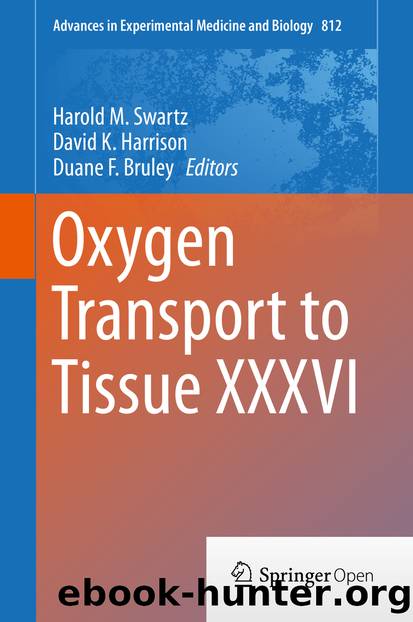Oxygen Transport to Tissue XXXVI by Harold M. Swartz David K. Harrison & Duane F. Bruley

Author:Harold M. Swartz, David K. Harrison & Duane F. Bruley
Language: eng
Format: epub
Publisher: Springer New York, New York, NY
3 Results
Time series data for the changes in scattering and absorption for all eight wavelengths are shown in Fig. 24.3b, c, respectively. The standard deviation of the scattering and absorption during baseline was 0.0002 mm−1. During the occlusion there were large changes in the absorption in some wavelengths, in particular there was a significant rise in absorption of 690 nm (sensitive to HHb) and significant decreases in 870 nm (sensitive to HbO2). The scattering also demonstrated some hetereogeneous large changes and we are currently investigating whether these might be due to crosstalk or other factors. Finally, the absorption data were fitted for HbO2 and HHb, the baseline total haemoglobin was 84.8 ± 0.3 μM l−1 and the absolute tissue saturation was 51.8 ± 0.5 %, comparable to previous studies in muscle [11]. Figure 24.3d shows the absolute concentration of oxyhaemoglobin and deoxyhaemoglobin during the study.
Fig. 24.3(a) Example TPSFs for single measurement. (b) Reduced coefficient of scattering for eight wavelengths over course of cuff occlusion. (c) Coefficient of absorption for eight wavelengths over course of cuff occlusion. (d) Concentration changes for HbO2 and HHb, cuff inflation time of 4 s
Download
This site does not store any files on its server. We only index and link to content provided by other sites. Please contact the content providers to delete copyright contents if any and email us, we'll remove relevant links or contents immediately.
| Administration & Medicine Economics | Allied Health Professions |
| Basic Sciences | Dentistry |
| History | Medical Informatics |
| Medicine | Nursing |
| Pharmacology | Psychology |
| Research | Veterinary Medicine |
Tuesdays with Morrie by Mitch Albom(4690)
Yoga Anatomy by Kaminoff Leslie(4305)
Science and Development of Muscle Hypertrophy by Brad Schoenfeld(4087)
Bodyweight Strength Training: 12 Weeks to Build Muscle and Burn Fat by Jay Cardiello(3913)
Introduction to Kinesiology by Shirl J. Hoffman(3725)
How Music Works by David Byrne(3186)
Sapiens and Homo Deus by Yuval Noah Harari(2987)
The Plant Paradox by Dr. Steven R. Gundry M.D(2547)
Churchill by Paul Johnson(2506)
Insomniac City by Bill Hayes(2496)
Coroner's Journal by Louis Cataldie(2432)
Hashimoto's Protocol by Izabella Wentz PharmD(2331)
The Chimp Paradox by Peters Dr Steve(2296)
The Universe Inside You by Brian Clegg(2097)
Don't Look Behind You by Lois Duncan(2078)
The Immune System Recovery Plan by Susan Blum(2027)
The Hot Zone by Richard Preston(1983)
Endure by Alex Hutchinson(1964)
Woman: An Intimate Geography by Natalie Angier(1882)
